Clarity Law
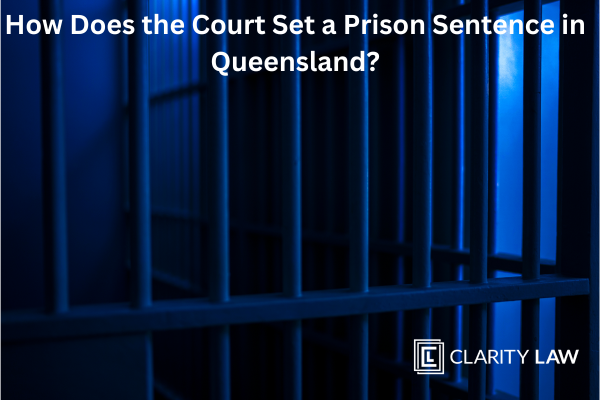
When imposing a prison sentence, a Queensland Court has two primary discretions. The first is to decide the length of the sentence, and the second is to set the release or eligibility date.
The basic structure of prison sentences
A prison sentence might be “six months imprisonment to be released on parole after having served two months”. This means that the prison sentence is six months, and the person is released from custody after two months. The remaining four months will be served on parole. Alternatively, the Court may order that the person serves four years to be eligible for parole after two years.
The two parts, then, are the length of the sentence, and then a parole release or parole eligibility date some time before the end of the sentence.
Setting length of the sentence
Sentencing in Queensland is a complex procedure in which the Court must consider many things, including:
-
The sentencing principles in the Penalties and Sentences Act;
-
Relevant case law (previously decided cases);
-
the maximum penalty of the offence;
-
the penalty submissions made by the prosecution;
-
the penalties submissions made by the defence;
-
the personal circumstances of the defendant;
-
the circumstances of the offence;
-
any victim impact statement;
-
the impact the offence had on an individual or the public generally;
-
any time in custody the defendant has already served before the sentence and;
-
the criminal history of the defendant.
As can be seen, there is a lot for the Court to consider.
The Queensland Supreme Court has said that sentencing is not a mathematical exercise. Judges and magistrates have a wide discretion in deciding how to impose a sentence. The primary approach is called an “instinctive synthesis”.
In practice, most judges and magistrates are likely to stay within the “range” of previously decided cases. “Range” means the upper and lower limits of the usual sentences imposed for a given offence. For example, a court is likely to impose a penalty of 18 months or more for drug trafficking. This is because most cases show sentences of 18 months imprisonment or more for that offence.
Setting the Release Date
It is rare for a defendant to serve the whole of the length of his prison sentence in custody. He will usually have the opportunity of parole.
As a general rule, a person who pleads ‘guilty’ to an offence will be released or eligible after serving approximately 1/3 of his or her sentence. A person who pleads ‘not guilty’ and loses the trial, will generally be released or eligible after 1/2 of the sentence.
The longer the sentence, the more difference this makes. The difference between 1/3 or 1/2 of six months is one month. The difference between 1/3 or 1/2 of five years is 10 months.
Release Date or Eligibility Date
When a court is deciding when to release a person on parole, it will impose either a “parole release date”, or a “parole eligibility date”.
A parole release date means the Court chooses the date of the defendant’s release. This can be anywhere from the first day of the sentence to the last day.
If the Court does not impose a release date, it will be an eligibility date. This means the Court will set the date for when the defendant is eligible to apply for parole. The defendant applies to the Parole Board for release. It is the Parole Board who decides his release date, as opposed to the Court. The parole board has up to 120 days after the prisoner’s parole application to decide whether to release the prisoner or not. The Parole Board may defer the decision to gather further information, in which case it has 150 days to decide. So, while the prisoner can apply for parole, it may not be granted for up to 150 days after his application.
What is the Most important factor for sentencing?
In our experience, every case is different, and no one case will necessarily be decided in the same way as another. However, the factors below will always be relevant.
The seriousness of the offence. This refers to how seriously the offence is considered at law. A person convicted of murder is always going to do jail time, regardless of every other factor, because of how serious the offence is. A person convicted of possessing a pipe to smoke drugs, however, is almost never going to be sentenced to jail. This is because the offence is not serious enough to warrant actual imprisonment.
Criminal history is a big factor. A person may commit an offence which is not especially serious, but because of his criminal history, it becomes serious. Breaching a domestic violence order is a common example of this. The breach itself may not be overly serious, but because the person has been sentenced for breaching domestic violence orders many times in the past, the Court may consider it has no other option but to impose actual imprisonment.
As outlined earlier, a court will consider previous cases which are similar to the one before it, and attempt to impose a sentence within those bounds. This is for the purpose of (among others) consistency. It would be unfair for one person to get a wildly different penalty from another person for the same offence.
Conclusion
This article is only an introduction to sentencing. We highly recommend if you are charged with any offence, let alone a serious one, that you engage experienced criminal law experts. Clarity Law can give you the individual advice and support you need to make the right move.
Why should I engage Clarity Law?
Quite frankly we care about getting the right outcome for our clients and helping them through one of the most difficult times in their lives.
In the face of a criminal law charge, selecting the right legal representation is paramount, and Clarity Law offers a unique blend of proficiency and empathy that sets us apart. Our firm is dedicated to providing clarity in the often complex world of criminal law. We believe that every client deserves a clear understanding of their rights and the legal process they're navigating.
Our experienced team of lawyers approaches each case with a commitment to open communication, ensuring you're informed every step of the way. With a proven track record of securing favourable outcomes, we have the expertise to navigate even the most intricate legal challenges.
At Clarity Law, we strive not only to be your staunch advocates but also to provide a supportive, understanding environment during this trying time. Choosing Clarity Law means choosing a team that will tirelessly work to protect your rights and pursue the best possible outcome for your case.
You can read more about our founder, Steven Brough’s, journey to starting Clarity Law by clicking here.
How do I get more information or engage you to act for me?
If you want to engage us or just need further information or advice then you can either;
-
Use our contact form and we will contact you by email or phone at a time that suits you
-
Call us on 1300 952 255 seven days a week, 7am to 7pm
-
Click here to select a time for us to have a free 15 minute telephone conference with you
-
Email This email address is being protected from spambots. You need JavaScript enabled to view it.
-
Send us a message on Facebook Messenger
-
Click the help button at the bottom right and leave us a message
We are a no pressure law firm, we are happy to provide free initial information to assist you. If you want to engage us then great, we will give you a fixed price for our services so you will know with certainty what we will cost. All the money goes into a trust account monitored by the Queensland Law Society and cannot be taken out without your permission.
If you don’t engage us that fine too, at least you will have more information on the charge and its consequences.
Other articles that may be of interest
The Role of Victims of Abuse in Domestic Violence Matters
Written by Russell Tannock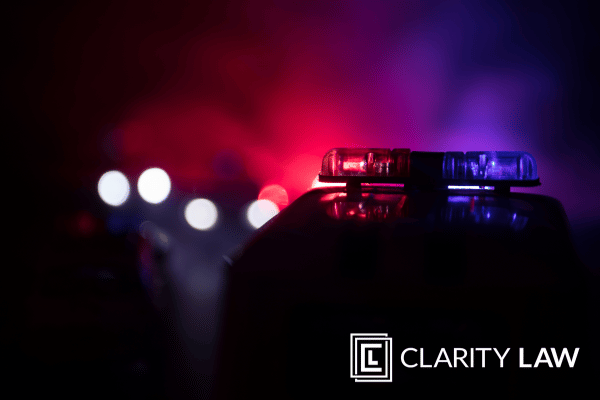
For criminal and domestic-violence lawyers in Queensland, the situation is all too familiar: a victim of domestic violence contacts us and asks whether they can withdraw a statement that they gave to the police following a domestic violence incident and force the police to take no further action against the perpetrator especially if the perpetrator has been refused bail and is in jail waiting for the charges to be finalised.
For us, this is particularly heartbreaking for two reasons: firstly, it is worrying for us to see any victim of domestic violence worried more about their attacker than their own safety. Secondly, our advice must always be that, while the victim can withdraw their statement, or refuse to provide further statements to police, this is unlikely to achieve their desired aims. The police can still take action against the perpetrator, either to pursue an application for a Domestic Violence Protection Order, or a charge of contravening an existing Domestic Violence Protection Order. This article explores the reasons why this is so and the powers that the police and the courts have to proceed in these matters in spite of the victim’s unwillingness to co-operate further with police and their desire to withdraw their application for a DVO.
*A note about terminology. For the purposes of simplicity, this article discusses domestic violence in the context of a heterosexual, cis-gendered, couple in a marital relationship where the wife is the victim and the husband the abuser. This reflects the current state of the research into domestic violence. However, it is important to note that Queensland’s domestic violence legislation is not gendered, nor is its protections limited to spousal or romantic relationships.
Police Applications for Domestic Violence Protection Orders and Applications to Vary DVO's
If police attend a domestic disturbance, they are empowered to apply to the court for a Domestic Violence Protection Order. Alternatively, the police may issue a Police Protection Notice, which operates in the same manner as a Temporary Protection Order. Once a Police Protection Order is issued, it automatically becomes an application for a Domestic Violence Protection Order before the nearest Magistrates Court.
The domestic violence legislation authorises the police to ask the court to make these Protection Orders despite the wishes of the person the Order purports to protect. Furthermore, the same Act explicitly states that the participation of the victim (referred to as an “aggrieved”) in proceedings is not necessary. This includes the aggrieved giving evidence. In other words, the police can ask the court to make a Domestic Violence Protection Order even if the aggrieved does not want the Order made or is unwilling to give evidence against her abuser (referred to as the “respondent”). There are good reasons why the legislation is structured this way.
Firstly, an aggrieved may be genuinely afraid of giving evidence against the respondent. In Australia, the murder rate of women by their partners or ex-partners is frighteningly high and physical violence in domestic relationships almost endemic. An aggrieved may be putting herself in genuine danger of retaliation from the respondent by giving evidence in court about the respondent’s abuse, as that respondent is also present in court when this evidence is given. In these cases, the courts and the police can intervene to protect the aggrieved while providing a “shield” for the respondent’s inevitable fury that he has been held to account for his own actions.
Secondly, many victims of domestic violence become so psychologically damaged by the abuse that they have suffered that they cannot bring themselves to leave their abuser. Many of them experience severe psychological distress even at the thought of being separated from their violent partner. Psychologists use phrases like “trauma bonding” to describe this state of mind. Again, the legislation allows the courts and police to offer protection to the aggrieved who is no longer able to act to protect herself from danger.
However, that is not the end of the matter. Notwithstanding the above provisions, the aggrieved is considered a party to the Domestic Violence Protection Order application and is permitted to appear at the hearing of the application and give evidence, should she so choose. If the aggrieved believes that she does not need the protection of the court to keep her safe from domestic violence and doesnt want the DVO to proceed she may elect to give evidence against the police’s application. This is a common occurrence in domestic violence hearings. It is then for the court to decide whether or not the Protection Order ought to be made regardless.
A word of caution: evidence in domestic violence proceedings is still sworn testimony and subject to the laws against perjury (which attract significant periods of imprisonment if found guilty).
Police-initiated applications to vary existing Domestic Violence Orders proceed in the same manner as the initial applications for Protection Orders. Again, the aggrieved is not required to participate; however, she may still elect to attend as a party to the application and give evidence as to why she believes that the court should not make the variations to the existing Protection Order sought by the police. Again, the court then decides the police’s application on the evidence.
Proceedings for Contravention of Domestic Violence Protection Orders
Contravening a Domestic Violence Protection Order is an offence. The maximum penalty for this offence is three years’ imprisonment for the first conviction and five years’ imprisonment for subsequent convictions (if they occur within five years of any previous conviction). Proceedings for contravention charges occur according to the usual procedure for criminal matters. It is also important to note that domestic violence incidents may also involve other criminal offences, such as assault, wilful damage, strangulation offence, stalking, etc.
Because abusers (“defendants” in criminal matters) rarely commit domestic violence in front of other witnesses, it is common for police to rely almost exclusively on the testimony of the victim to secure convictions. Initially, police may obtain the victim’s testimony via body-worn-camera footage captured during the initial investigation. Police may also get the victim to sign a “notebook statement”; ie, get the victim to sign a brief, written statement recorded in a police officer’s notebook. However, if the defendant elects to plead not guilty and go to trial, the victim will need to give oral testimony in court.
It is important to note that a victim of domestic violence becomes a police witness once the defendant is charged with criminal offences. If the defendant attempts to “persuade” the victim to withdraw her statement, he may be charged with an offence against the administration of justice (again, these offences attract significant periods of imprisonment if found guilty).
In the aftermath of a domestic violence incident, it is a frequent occurrence that the victim tries to withdraw her complaint and retract her statement. She may attend the police station, speak to the investigating police officer, and tell them that she no longer wishes to have the defendant charged. However, the police do not act as mere “agents” of the victim. Once the police decide to charge the defendant with a contravention offence, it is entirely a decision of the police whether they will proceed with the prosecution. While the reluctance of the victim to testify “against” the defendant may be a factor that the police take into account when deciding whether they are likely to secure a conviction, it is not fatal to their case. On the contrary, there are a number of things that the police may do at trial to still get the victim’s testimony into evidence, even if she is reluctant to do so.
Firstly, any version of events that the victims gives, and is recorded on body-worn-camera footage, is admissible as evidence at trial, even if the victim refuses to attend court to confirm that version of events. Secondly, the police may ask the court to issue a summons, which is an order of the court compelling the victim to attend court and give evidence. If the victim does not obey the summons, the court may issue a warrant for her arrest.
If the victim still refuses to co-operate with the prosecution once she is sworn in as at witness, the police prosecutor may make an application to the court for her to be declared an “adverse witness”. This allows the prosecutor to dispense with the usual rules of examination-in-chief and get the victim’s testimony regardless of her reluctance to participate.
At first blush, this treatment of a domestic violence victim by the court and the police may appear almost brutal. In reality it is. Again, the data from psychological research suggest that victims of domestic violence may be “retraumatised” by court proceedings and by being forced to relive the experience of abuse. Fortunately, in our experience, domestic violence matters usually resolve long before these steps need to be taken. Most of us who work in domestic violence matters are aware of the severe, negative impact proceedings may have on the victim and work hard to minimise any further suffering to the victim.
The court also has procedures to attempt to minimise this retraumatising of the victim. For example, the court may permit the victim to give her testimony from a separate room, away from the defendant, and broadcast her testimony via video-link into the courtroom.
There is also other evidence that police prosecutors may be able to rely on to secure a conviction. For example, photographs of injuries to the victim, photographs of damage to property, testimony of neighbours (who may have heard yelling, screaming, breaking), etc.
Conclusion
The legislature, the police, and the courts are taking an increasingly harsh stance against domestic violence. The domestic violence legislation gives both the police and the courts powers to intervene into people’s otherwise private lives to ensure the protection of victims of domestic violence. Consequently, it is increasingly difficult for victims of domestic violence to try to persuade the police and/or the courts to make complaints against their abuser just “go away” without further action by either witdawing there statement in regards to the DVO or asking the police to withdraw the application for a DVO.
Therefore, if you have been charged with contravening a Domestic Violence Protection Order, you can expect that the police and the courts will pursue the matter until it is decided either by your plead of guilty or at trial, if you decide to plead not guilty. Even if the other person involved in the alleged incident attempts to withdraw their statements or their complaint to the police about the domestic violence allegation you can expect that the matter will still proceed regardless.
How do I get more information or engage you to act for me?
If you want to engage us or just need further information or advice then you can either;
-
Use our contact form and we will contact you by email or phone at a time that suits you
-
Call us on 1300 952 255 seven days a week, 7am to 7pm
-
Click here to select a time for us to have a free 15 minute telephone conference with you
-
Email This email address is being protected from spambots. You need JavaScript enabled to view it.
-
Send us a message on Facebook Messenger
-
Click the help button at the bottom right and leave us a message
We are a no pressure law firm, we are happy to provide free initial information to assist you. If you want to engage us then great, we will give you a fixed price for our services so you will know with certainty what we will cost. All the money goes into a trust account monitored by the Queensland Law Society and cannot be taken out without your permission.
If you don’t engage us that fine too, at least you will have more information on the charge and its consequences.
Other articles that may be of interest
What is a Barrister and Why Would I Need one?
Written by Jacob Pruden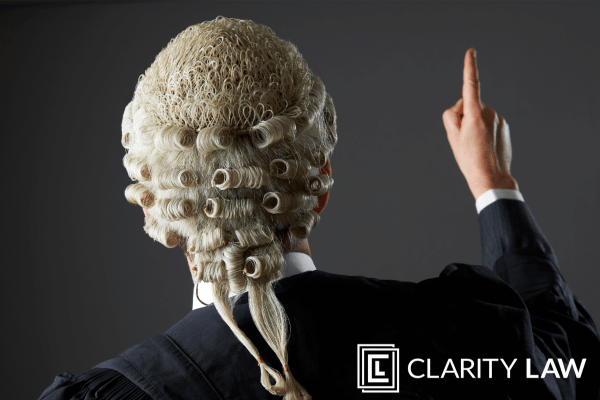
The lawyers at Clarity Law are traditionally called solicitors. Clarity Law sometimes hires barristers to assist our clients.
What is the difference between a solicitor and a barrister, and why might you need one?
The Short History of Barristers
The profession of barristers, often referred to as advocates or counsel, boasts a rich and storied history dating back to ancient Rome. The origins of barristers can be traced to the Roman legal system, where specialized legal representatives known as "orators" were entrusted with presenting cases in the forum. This early incarnation laid the groundwork for the development of barristers in later legal systems.
The modern concept of barristers as distinct legal professionals emerged in England during the late Middle Ages. By the 16th century, the legal profession had become divided into two distinct groups: solicitors, who handled legal matters outside of court, and barristers, who were trained to argue cases before the courts.
In Australia, the tradition of barristers was inherited from England, and it was further shaped by the evolving legal landscape of the 19th and 20th centuries. The establishment of the Queensland Bar Association in the late 19th century marked a significant milestone in the formalization of the barrister profession in Queensland. Since then, barristers have played a vital role in the legal system, providing specialised advocacy, legal expertise, and representation in courts of law.
Why do Barristers wear Robes and a Wig?
Barristers wear robes and wigs as part of a traditional legal dress code that has its roots in English legal history. Here are the main reasons for this practice:
-
Historical Tradition: The tradition of wearing robes and wigs dates back several centuries to the 17th century in England. At that time, it was customary for members of the upper classes to wear formal attire when appearing in public, and this practice extended to the legal profession.
-
Symbol of Impartiality: The uniformity of robes and wigs is intended to create a sense of neutrality and impartiality. By concealing personal clothing and hairstyles, it emphasizes that the focus should be on the law and the proceedings, rather than the individual barrister.
-
Professionalism and Dignity: The attire is seen as a sign of professionalism and respect for the legal process. It sets a formal tone for court proceedings, underscoring the seriousness and importance of the matters being discussed.
-
Equality in Appearance: Robes and wigs serve to diminish distinctions in appearance between barristers. This is important in conveying the idea that all barristers are equal before the law, regardless of their personal background or status.
-
Historical Continuity: By adhering to these longstanding traditions, the legal profession pays homage to its historical roots and demonstrates continuity in the practice of law.
-
Identification of Role: The attire helps to distinguish barristers from other participants in the legal process, such as solicitors, judges, and court staff. This clear visual distinction aids in the smooth functioning of court proceedings.
-
Courtroom Decorum: The formality of the attire contributes to the overall decorum of the courtroom, reinforcing the gravity of the proceedings and creating a structured environment.
It's worth noting that while this tradition is still observed in some jurisdictions, it has evolved or been abolished in others. In Queensland the wearing of wigs and robes has been reduced with a greater emphasis on practical and comfortable courtroom attire. In most cases robes and wigs are only worn in the District or Supreme Court involviong criminal matters.
What’s the Difference Between a Barrister and a Solicitor?
The main difference between a barrister and solicitor is a barrister specialises in ‘higher’ court work, and he or she will tend to have less contact with a client, tending to have the client’s instructions conveyed to him through the solicitor. A barrister is a sole trader. Clients will generally not go directly to a barrister, but rather, solicitors approach the barrister to give him work. He is required to accept that brief and perform all work expected under the retainer.
Queensland has a court hierarchy. The highest court in the state is the Supreme Court, followed by the District Court, followed by the Magistrates Court. Barristers will tend to work in the Supreme Court and the District Court. Barristers will often be called upon to do anything more complicated than an adjournment in those courts, which can include trials, pre-trial applications, and sentences. Because barristers appear in those higher courts often, they will be well armed with knowledge of the different judges in those courts, as well as the most up-to-date case law relevant to the charges litigated in those courts.
A solicitor, on the other hand, will be the primary contact for the client. It will often be a solicitor who does the paperwork and who organises the preparation of documents such as character references, personal statements, and psychological reports. The solicitor will be the primary point of contact for the various agencies (prosecution, community corrections, the courts etc). Solicitors will tend to do most kinds of work in the Magistrates Court. More experienced solicitors may appear in the District Court and Supreme Court. Solicitors will be involved in the case from the start, whereas barristers only come into the picture later. In more complicated court proceedings, both the barrister and solicitor will appear in the court, but the barrister will speak to the judge or jury directly while the solicitor ‘instructs’ in a supporting role.
Why Would I Need a Barrister?
Mostly it comes down to expertise and experience. While we at Clarity Law have the skills and experience needed to do some things in the higher courts, we are just never going to have the same level of experience in those higher courts as a barrister. This is because the vast bulk of our work is concentrated in the Magistrates Court, whereas a barrister is almost always in the higher courts. Barristers are particularly helpful for complicated processes. For example, a trial by judge and jury is a complex and time-intensive undertaking. Barristers are trained and experienced in the rules of evidence, questioning witnesses, and preparing speeches for a jury. A solicitor will often lack this training and experience, or, if the solicitor has it, it will be basic compared to that of a barrister.
Another upside of retaining a barrister is there will be two heads working on a case instead of one.
How is a Barrister Chosen?
Speaking for myself, I have a pool of trusted barristers from which I recommend. The barrister I recommend to a client will depend on a few factors such as the barrister’s proven record with certain types of charges, the personality of the barrister and how well that might fit with the client, and how available a given barrister might be for the work I would need him to do. Choosing the right barrister will depend on the circumstances of the case and the needs and personality of the client. The client need not take my recommendation, but usually does.
Conclusion
Most of the time a barrister will come recommended for more complicated court procedures, especially those in the District and Supreme Courts. As always, whether a barrister is needed will be dependent on the specific circumstances of the client’s case. Suffice it to say, should a barrister be required, Clarity Law will choose a barrister we think best fits the requirements of the case and the client.
How do I get more information or engage you to act for me?
If you want to engage us or just need further information or advice then you can either;
-
Use our contact form and we will contact you by email or phone at a time that suits you
-
Call us on 1300 952 255 seven days a week, 7am to 7pm
-
Click here to select a time for us to have a free 15 minute telephone conference with you
-
Email This email address is being protected from spambots. You need JavaScript enabled to view it.
-
Send us a message on Facebook Messenger
-
Click the help button at the bottom right and leave us a message
We are a no pressure law firm, we are happy to provide free initial information to assist you. If you want to engage us then great, we will give you a fixed price for our services so you will know with certainty what we will cost. All the money goes into a trust account monitored by the Queensland Law Society and cannot be taken out without your permission.
If you don’t engage us that fine too, at least you will have more information on the charge and its consequences.
Other articles that may be of interest
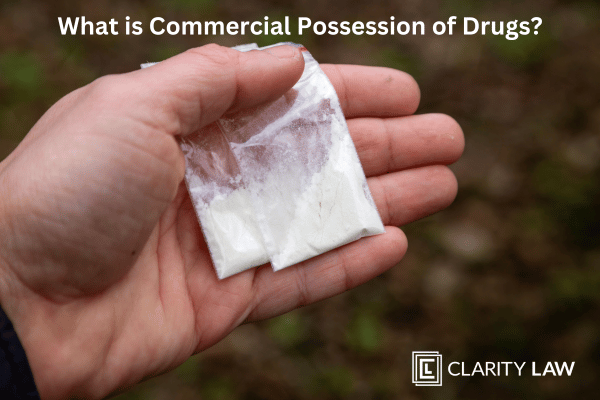
The Queensland laws that regulate the possession of illegal drugs are The Drugs Misuse Act and the Drugs Misuse Regulation. To determine the seriousness of drug possession, the law distinguishes by the quantity, type, and purpose of the drug possessed. For example, possession of a small amount of cannabis for personal use as compared to 50 grams of methylamphetamine for commercial sale, will have starkly different legal consequences for the defendant.
What is Commercial Possession?
The Drugs Misuse Regulation 1987 classifies drugs into schedule 1 and schedule 2. Then the quantity of each classification is split into three quantity scales, specified under schedule 3 and schedule 4. These classifications are relevant for the purposes of punishment.
The most common schedule 1 drugs are: types of amphetamines, cocaine, heroin, and anabolic steroids.
The most common schedule 2 drugs are: cannabis, alprazolam, codeine, diazepam, and hallucinogenic compounds.
Section 9 of the Drugs Misuse Act 1986 penalises drug possession in this manner:
In short, possession of a drug is presumed to be commercial if it is over 200 grams for schedule 1 drugs or over 500 grams for cannabis.
It is not always the quantity which is determinative of whether possession is commercial. Sometimes the prosecution will allege that a drug was possessed for a commercial purpose even if it is not over schedule 4. For example, if one person had 15 grams of methylamphetamine in his possession, then it is highly likely that the prosecution would allege there was at least the potential for the drugs to be applied in a commercial way. Another example might be where a person has 1.9 grams of cocaine in his possession, plus $2,500 cash, plus text messages on a phone which appeared to be arranging the supply of drugs. In such a situation, the prosecution would almost certainly allege that the drug possession was for a commercial purpose.
Which court would the case be heard in?
Possessing a schedule 1 drug in excess of schedule 3 or 4 – Supreme Court.
Possessing a schedule 2 drug in excess of schedule 3 – District Court.
Possessing a schedule 1 or 2 drug below schedule 3 – District Court.
All offences can be heard in the Magistrates Court, but only at the prosecution’s discretion. In our experience, it is not common for the prosecution to elect a summary/Magistrates Court hearing in instances where the drug (excluding cannabis) is in excess of 2 grams, and especially where there are allegations of commerciality. We will, however, always try to keep a client’s case in the Magistrates Court to minimise expense, delay, and penalty.
What is the Punishment for Commercial Possession?
Like with any sentencing, there is no one sentence which would be imposed for possession of dangerous drugs, because there are many different circumstances for these offences. They can include the quantity of the drug, the type of drug, whether the drug was possessed for a commercial purpose, whether there are other charges surrounding the drug [supplying, for example], the criminal history of the defendant, any rehabilitation undertaken, and other personal circumstances of the defendant.
Suffice it to say, actual imprisonment is available to the Court for these offences. The arguments of the defence lawyer tend to focus on whether the defendant should be released on parole the day of his sentence, or, if that is not possible, then minimising the time spent in actual custody.
Can I get Drug Diversion?
Drug diversion is available for some drug offences, but this is in relation to possession of small amounts of drugs for personal use, and it would be heard in the Magistrates Court. Drug diversion is not considered appropriate by the District or Supreme Court.
Conclusion
If you are charged with any kind of drug possession, but especially possessing larger amounts, we highly recommend quality representation. We at Clarity Law are highly experienced, and with over 100 happy clients leaving 5-star Google reviews, we are confident we can get you results.
How do I get more information or engage you to act for me?
If you want to engage us or just need further information or advice then you can either;
-
Use our contact form and we will contact you by email or phone at a time that suits you
-
Call us on 1300 952 255 seven days a week, 7am to 7pm
-
Click here to select a time for us to have a free 15 minute telephone conference with you
-
Email This email address is being protected from spambots. You need JavaScript enabled to view it.
-
Send us a message on Facebook Messenger
-
Click the help button at the bottom right and leave us a message
We are a no pressure law firm, we are happy to provide free initial information to assist you. If you want to engage us then great, we will give you a fixed price for our services so you will know with certainty what we will cost. All the money goes into a trust account monitored by the Queensland Law Society and cannot be taken out without your permission.
If you don’t engage us that fine too, at least you will have more information on the charge and its consequences.
Other articles that may be of interest
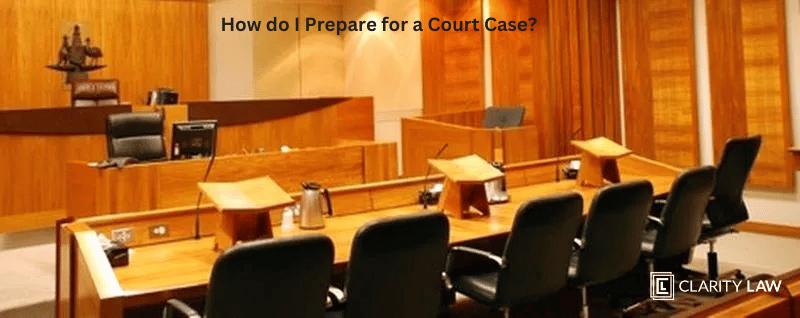
Introduction
How you prepare for a court case is very much dependent on the type of matter you have and what you intend to do with it. This article covers some of the basic preparation you should do if represented by Clarity Law.
Instructions
The most basic thing you need to do is provide us with “instructions”. Providing instructions means you tell us what you want to do with your case. It also means giving us information and documents which could be helpful for your case. Your instructions will also provide us with useful background about you and your case. We will confirm your instructions in writing so we are clear on what you want us to do.
Sometimes, instructions are straightforward. If you wish to plead guilty to a mid-range drink driving offence and make an application for a work licence, then we know we need to prepare affidavits and then represent you in court.
If you want us to commence negotiations with the prosecution, then we would analyse prosecution evidence and draft arguments.
In essence, your instructions guide the direction of the case.
Personal or Trial Statements
If you want us to represent you for a plea of guilty for a serious offence, we will often ask you to provide a personal statement. This will tell us information about your background, such as: where you grew up, what grade you got to in school, and whether both parents were around. It will include your work history and may contain psychiatric and substance use history. The purpose is for us to get a better understanding of who you are, and then to present that in a way most helpful to you in court.
Let us assume your charge is drug possession. If you grew up in a household where drug taking was normal, and you first tried drugs when you were 13, this would be important for the Court to know. We could only share such things with the Court by getting it from you.
A trial statement is something different in nature. If you want to take your case to trial, then we will need the exact basis on which you are contesting each charge. We will ask you to write a paragraph-by-paragraph response to the police case / complainant’s statement. This allows us to understand the grounds on which you contest the case, and helps us form the basis for a case theory. The case theory informs the case strategy. We need a case strategy to win.
Documents
We will commonly ask you to give us documents such as character references, medical notes, or any proof of rehabilitation, if relevant. These will be used as supporting material in court.
Sometimes your documents can help us with drafting negotiations to the prosecution. Let us say you are charged with unlicensed driving while SPER suspended. Maybe you did not know your driver licence was suspended because SPER sent a letter to your old address. If you gave us a copy of your driver licence confirming your current address, we could use that to back-up your claim you did not know.
Rehabilitation
When a Court sentences you, it must consider sentencing principles. One of the principles in your favour is rehabilitation. Rehabilitation means any efforts you have made to change your habits or circumstances since the offence.
If you are charged with a drink or drug driving offence, then we will usually recommend you undertake the "Queensland Traffic Offenders Program".
If you are charged with an offence of violence, then it is often wise to undertake anger management or other counselling.
If you are charged with a domestic violence offence, then undertaking a program such as “Men Choosing Change” would be a good choice.
If you are charged with a drug offence, then getting clean drug screens or residential rehabilitation would be suitable.
Writing a letter of apology to the complainant would show that you have insight into your wrongdoing, and demonstrates remorse. Demonstrating remorse can persuade a Court you are more likely to rehabilitate.
There are many ways to prove rehabilitation, and we can advise you of the most effective way to do so, based on the circumstances of your case. The key is to do it and then prove you have done it.
Choosing an Outfit
When attending a court, we recommend business wear; something that looks professional. This shows a degree of respect to the Court and shows that you are taking the case seriously. You may be surprised some people present to Court in a singlet, shorts, and thongs. We cannot prove they get worse outcomes due to their appearance, but basic psychology would suggest it could be a factor.
Conclusion
These are some, but not all, of the main ways in which you can prepare for your case. If you are engaging us then you will naturally expect us to do most of the work, but there are some things we will need you to do to help us prepare your case. Suffice it to say, if you follow through on the preparation that we ask of you, it will only help things go in your favour when we represent your interests.
I didn’t do it! What to do if Accused of a Crime you didn’t Commit
Written by Jacob Pruden 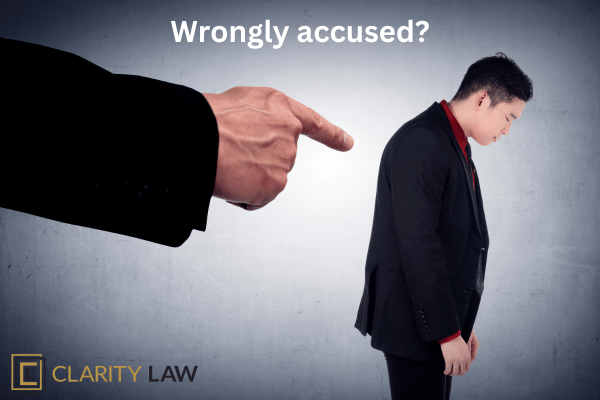
Theoretically, our system of criminal justice is set up to give the best possible chance to an innocent person to avoid a criminal conviction. If you are falsely accused of a crime there are strategies to give you the best defence.
Fundamental Principles
There are a few fundamental principles that are intended to act as safeguards in the event of a falsely accused person. They are called:
- Innocent until proven guilty,
- The burden of proof,
- Proof beyond reasonable doubt.
Innocent until proven guilty.
This means exactly what it sounds like: an accused person is presumed innocent until he is proven guilty of a charge. The prosecution must prove the charge through admissible evidence. This evidence can be witness statements, CCTV, forensics, documentary evidence, photographs, or even the accused person's own confession.
The burden of proof.
The prosecution must prove the charges against the defendant. This is known as the burden of proof, because they have the burden of proving their case. The defendant does not have to prove anything. If the defendant wishes, he can try to set up a positive case proving his innocence. But the jury is not allowed to draw an adverse inference against him if he chooses not to do that.
Proof beyond reasonable doubt.
This means the prosecution must prove their case to such an extent that the jury is left with no reasonable doubt about the person's guilt. It isn’t that the accused might be guilty or is even probably guilty, but the jury must be left without any sensible doubt of their guilt.
Interview
Nine times out of 10, our advice is for you not to give an interview to police. There are various reasons for this. One of the big ones is, if the police don’t have enough evidence, or have very thin evidence, but then you give an interview, there is a possibility you will say something self-incriminating. Most police are seasoned interrogators, and in our experience, it is only on TV programs that a defendant manages to outsmart or bamboozle police in an interview. Think about it: they interview suspects as part of their day job; you may have never even interacted with police before this moment. So, you are already at a distinct disadvantage.
However, there may be rare instances where giving an interview is the right move. You do not want to try this without legal advice and without a lawyer attending with you. For example, if you are accused of being at East Brisbane on the night of the alleged offence, but you can prove you were at Toowoomba that night, then it may be worth confirming that early with police in an interview. But as I said earlier, this would only be in rare cases and after careful consideration with legal advice. There is a chance in giving the interview that police will not choose to charge you because of what you tell them or what you can prove to them.
If you want to learn more see our article on your right to silence.
Negotiations
If you are charged, then the next port of call is to negotiate with the prosecutors. The intention here is to persuade them to drop the charge(s) against you. There are various ways this can be argued: either they have a lack of evidence, or you are able to present evidence that shows your innocence. For example, we had a client who was charged with drink driving. The car was parked in a car park, the client was seated in the passenger seat, and the car was registered to a different owner. We were able to present a statutory declaration from the client’s friend that he in fact drove his car to the location with our client as a passenger, and then left our client in the car while he went and got himself a haircut. Police confirmed the car belonged to our client’s friend, had no evidence that contradicted the friend’s statutory declaration, and therefore decided to drop the charge.
The above is a simple example of negotiations, but the point is they can be essential in getting you out of wrongly laid charges.
Check out our article on negotiating with a prosecutor.
Disclosure
The accused is legally entitled to ask for disclosure from the prosecution. What this means is we will ask the prosecution to provide us with all of the evidence they have in their possession to do with the case, whether helpful to the prosecution or helpful to the defence. Disclosure can include conferencing notes with witnesses, the internal police narrative on their database, criminal histories of prosecution witnesses, among others. With the widespread use of body worn camera footage, this can occasionally be quite helpful for a defendant. It may show a rather different version of events than what is reported in the police version of the facts.
Obtaining disclosure and analysing it carefully is critical, because it can provide an advantage to a defendant for negotiations or for trial. For example, internal police notes may show that their main prosecution witness has made allegations against other people previously and that those allegations had not been prosecuted due to insufficient evidence. Or perhaps a prosecution witness’s criminal history shows they are a person of poor character. Sometimes you might even strike gold with body worn footage and it may capture illegal police conduct which allows for the exclusion of certain evidence.
In any case, in an instance where you are falsely accused of an offence, you want the prosecution to give you everything they have which they say proves their case, so we can search for inconsistencies, or, if they don't have much evidence, then we can start to set up a an affirmative case against their case to make our case look much stronger than theirs.
Trial
Sometimes, despite our best efforts, the prosecution stubbornly presses on with the charges and forces us to take the case to trial. It is an unfortunate reality that they can press on with a weak case right up to the week before a trial. In the meantime, the poor defendant is losing sleep with stress and worry about his fate. Nevertheless, there will be times where an innocent person will have to take the case all the way to the conclusion of a trial. A trial means there will be a judge and jury, and the jury must decide if the defendant is guilty of the offences ‘beyond reasonable doubt’.
For a trial, preparation is half the battle. That means we come to court prepared with a case strategy, with a comprehensive version of your instructions, a carefully constructed case plan which breaks down all the weaknesses in the prosecution case, and ways in which to best exploit those weaknesses. In a sexual assault case, the defence case theory may be “it was consensual”. Then the defence strategy would centre around trying to show that the evidence supports the defence case.
Obviously, every case is different, and it can only really be with expert legal advice and representation that you can properly set yourself up for a trial if you are forced to take it all the way to the end.
Conclusion
The foregoing is only a brief overview of the different things you can do, and the different strategies you can try if you are wrongly accused of an offence. To have the best chance possible, you are going to need experienced lawyers. Clarity Law does no legal aid cases. That mean all attention will be focused on giving you the best defence possible. Our aim will always be to get a favourable outcome without the need of going to trial. But if a trial becomes necessary, then we have the experience to do the best preparation and give you the best chance possible.
How do I get more information or engage you to act for me?
If you want to engage us or just need further information or advice then you can either;
-
Use our contact form and we will contact you by email or phone at a time that suits you
-
Call us on 1300 952 255 seven days a week, 7am to 7pm
-
Click here to select a time for us to have a free 15 minute telephone conference with you
-
Email This email address is being protected from spambots. You need JavaScript enabled to view it.
-
Send us a message on Facebook Messenger
-
Click the help button at the bottom right and leave us a message
We are a no pressure law firm, we are happy to provide information to assist you, if you want to engage us then great, if not then you at least have more information.
Other articles that may be of interest
Brief of Evidence – why is it so important?
Written by Jack Marshall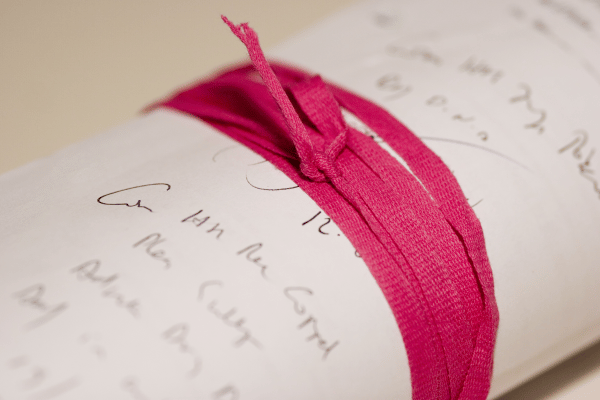
In this article we will very briefly cover what a Brief of Evidence is and why it is important to the conduct of a criminal or traffic matter.
It is important to distinguish that not every matter will have a Brief of Evidence produced. For a matter that is straightforward and uncomplicated, a Brief of Evidence is not going to be important – if there is no real question as to what occurred then the matter will progress without it. Producing a Brief of Evidence may have the detrimental effect of delaying your matter in this circumstance.
Criminal matters, much like most aspects of life is ambiguous and not always so clear cut. It is these times where your legal representative will request a Full Brief of Evidence.
What is a Brief of Evidence and how does it differ from the QP9?
The Brief of Evidence, rather self-referentially is all of the evidence on which the prosecution intends to rely in the matter. It often contains correspondence (such as text messages), footage from the Police during arrest and interviews, CCTV or witness provided footage, and statements from the officers involved, witnesses and importantly victims. The copies of these items are made available in the brief and will allow a defendant or their legal representative to do a thorough review of the evidence.
This information, prior to being formalised in a brief forms the basis of the QP9, which as I am fond of describing – is as a bias snapshot of a moment or moments in time, told from the perspective of the police aimed to securing a prosecution. This obviously doesn’t mean that facts have been exaggerated or added to make the charge seem stronger, however the QP9 can be wrong. Criminal Lawyers negotiate agreed facts on a regular basis.
Why do we need the BOE?
The BOE is absolutely necessary when conducting complicated case conferencing and giving a client their options regarding their position to defend some or all of their charges.
The BOE allows your legal representative to see what the prosecution are relying on and can then decide whether or not there is sufficient evidence to secure a prosecution or if there is room to mount a defence to the charge.
The Brief of Evidence is also critical when preparing a matter for a sentence and even more so when preparing for a trial, where the evidence will be tested.
How long does it take a Brief of Evidence to be produced?
The real answer is that there is no hard and fast time in which it takes for a Brief to be produced. The first instance will typically be the Court ordering the production of the brief, and giving a deadline for that production. But it is common that briefs are not produced by that time, this can be due to delays in scientific testing of evidence to witness availability.
If a brief is not disclosed in time, your legal representative will advise the court and the matter will usually be adjourned to allow additional time for the brief to be disclosed.
I have a Brief of Evidence for my matter, but haven’t engaged a lawyer – what are my options?
It is not uncommon for people to start their matter on their own and through the course of them handling their matter, they will be given a copy of their Brief. It is at this time, some people may become overwhelmed by the information they’ve been given or not understand how it relates to their legal options. You can absolutely bring your brief to a lawyer to get advice or to represent you. Good criminal defence firms can conduct a review of a Brief and give you your options, whether that means having them represent you or you continue your matter on your own.
It is typically in a person’s best interest to get legal advice when they have a matter that warrants the production of a Brief of Evidence. There can be a considerable amount of information in these Briefs which must be considered to determine what the best legal option is.
Conclusion
This article, is by no means a comprehensive review of what a Brief of Evidence is, or why it is important to engage legal representation when you have a matter that warrants one. This article is designed to give you an overview of a term that occurs in the course of many matters, to enable you to make the most informed decision before commencing on your legal journey alone or if you engage an experienced legal practitioner to assist you.





